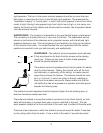
In particular, the surround speakers depend on non-absorptive surfaces for their opera-
tion, since they radiate virtually no sound directly at the listeners.
The best arrangement of the absorptive and non-absorptive surfaces in the room can
be seen in the diagram below. Most of the room surfaces are relatively absorptive, with
the notable exception of the rear wall and the highest portions of the other walls, which
should be diffusive.
“SLAP” ECHOES
“Slap” echoes are common in rooms which have parallel walls with little or no absorp-
tion or diffusion. Sounds tend to bounce back and forth between the parallel wall many
times before they die out, causing a characteristic bright, “zingy” sound and interfering
with the intended tonal balance and acoustic nature of the soundtrack.
Walk slowly through the room, clapping your hands. No clear reflections should be
heard at any point in the room—especially not near the primary seating area. Listen for
a “flutter echo” of the hand clap (a rapidly-repeating percussive sound, indicative of
the sound bouncing between two parallel walls). Again, the best home theatres are
fairly “dead” acoustically. This allows the program material and the playback system to
create the environment, rather than having the room’s native acoustic signature color
everything. You can also use the hand claps in chapters 17 and 18 of
WOW!
The solution for slap echoes is usually a combination of absorption and diffusion.
Specifically, placing absorptive material behind the front speakers (heavy drapes,
fiberglass, dense foam) and diffusion in the rear of the room (bookcases, irregularly-
shaped furniture, etc.) will deliver the greatest benefits. This will effectively suppress
the slap echoes while at the same time providing a diffusive surface in the rear for the
surround speakers. This enhances the enveloping characteristic of the surrounds even
further.
In those relatively rare cases where you have the luxury of building the home theatre
room from scratch, consider using non-parallel surfaces in the construction of the
room. A difference of as little as 6° will break up the slap echoes very effectively. For
example, “flaring” the side walls out from the front by approximately 6° and having the
ceiling rise toward the rear of the room at a comparable rate will do wonders for the
room’s acoustics,
if the wall design is solid and the angles are clearly intentional from
the outset.
11


















